Cycling in Spain this Summer - Advice and Routes
Saturday, June 29, 2024
As summer is now in full swing and many have some time on their hands, it is time to share some of the best cycling routes around Spain for those who fancy pedalling a little. If you are into cycling, be sure to follow this advice if you are not familiar with cycling in the Spanish Summer:
Riding a bicycle for long distances in the Spanish summer can be an exhilarating experience. However, the intense heat during this season necessitates proper preparation and precautions to ensure a safe and enjoyable journey. Here are some tips to help you handle long-distance cycling in the Spanish summer heat:
1. Stay Hydrated
- Carry enough water: Ensure you have enough water for your trip. Consider using hydration packs for easy access while riding.
- Electrolyte balance: Along with water, consider carrying electrolyte drinks or salts to replenish lost minerals through sweat.
2. Plan Your Route and Timing
- Avoid peak heat hours: Try to ride early in the morning or later in the afternoon when the temperature is cooler. Avoid cycling during the midday heat (12 PM - 3 PM).
- Choose shaded routes: Whenever possible, plan your route through areas that offer shade to protect against the sun.
3. Dress Appropriately
- Wear light and breathable clothing: Choose light-colored, loose-fitting clothes that reflect the sun's rays and allow your body to cool.
- Sun protection: Use a high SPF sunscreen, wear sunglasses for UV protection, and consider a cycling cap under your helmet to protect your head.
4. Pace Yourself
- Listen to your body: The heat can affect your performance, so it's crucial to pace yourself and take breaks whenever needed.
- Adapt your speed: Recognize that your average speed might be lower than in cooler conditions. Don't push yourself too hard.
5. Rest and Cool Down
- Take regular breaks: Use rest stops to cool down, drink water, and rest in the shade.
- Cooling accessories: Consider using cooling towels or misting yourself with water to help reduce your body temperature.
6. Stay Nourished
- Energy intake: Carry snacks or energy bars to replenish your energy stores during long rides.
- Balance your meals: Ensure you have a good balance of carbohydrates, proteins, and fats in your meals before and after the ride.
7. Bike Maintenance
- Pre-ride check: Ensure your bike is in good condition before heading out. Pay attention to tyre pressure, brakes, and the chain.
- Carry a repair kit: Have a basic repair kit and know how to fix a puncture or adjust your bike if needed.
8. Stay Informed and Safe
- Weather updates: Keep an eye on the weather forecast and be prepared for any sudden changes.
- Let someone know: Always inform someone of your route and expected return time.
9. Adjust for Terrain and Distance
- Train for your ride: If expecting hilly terrain or planning an exceptionally long distance, make sure you've trained in similar conditions.
- Plan for stops: Know where you can stop for water or assistance along your route.
Embarking on a long bicycle ride in the Spanish summer heat can be a challenging yet rewarding experience. With the right preparation, you can enjoy the beauty of Spain safely and comfortably. Remember, the key is to stay hydrated, protected from the sun, and to listen to your body’s signals to avoid heat-related illnesses.
Here are some of the best and safest routes you can follow to discover rural Spain:
Vía Verde de Ojos Negros (from Teruel to Valencia)
The longest of a nationwide network of Vía Verdes (literally, Green Ways) along disused railroads, the Ojos Negros route runs for 160 kilometres in two stages. The first is in Teruel province and passes through the Sierra Menera, while the second descends through the interior of Valencia down to the coast.
The Transpirenaica (from Cabo de Higuer to Cabo de Creus)
This trans-Pyrenees route runs for close to 800 kilometres along the southern slopes of the mountain range, from the Cantabrian coast (Cabo de Higuer, Hondarribia, Irún) to the Mediterranean (Cabo de Creus, in Girona province). Or vice versa. Part of the Europe-wide GR network of footpaths, its distinctive red and white markings have guided thousands of cyclists from around the world through protected areas in the Basque Country, Navarre, Aragon, Andorra, and Catalonia dominated by 3,000-meter peaks and with accommodation available in picturesque mountain villages. The perfect combination of nature, landscape, history, and cuisine.
The French Way of the Camino de Santiago
https://es.wikiloc.com/wikiloc/view.do?id=7623794
Those in the know say the French Way (Camino Francés) of the Camino de Santiago (which runs for nearly 800 kilometres between Saint Jean de Pied de Port, in France, and the cathedral of Santiago de Compostela in northwestern Spain) is the best of the five major Saint James pilgrim routes. It’s easy enough at almost any time of year and offers a tremendous range of landscapes, architecture and cuisine, with any number of historical sites, cathedrals, monasteries, churches, fountains, hostels, restaurants and other facilities. This route is stage one, if you go to the link it will explain the following stages of the route.
The Vía de la Plata Route
https://es.wikiloc.com/wikiloc/view.do?id=8482708
The Via de la Plata Route, a network made up of 26 towns and cities, from Gijón on the Cantabrian coast to Seville, in Andalusia, in collaboration with four regional governments, has set up a bike route (also available on an app), with information and advice for cyclists, along with the best routes for road racers or off-road bikes, as well as a passport that gives holders discounts in establishments along the ancient trade route dating back to before the Romans – the name of which, contrary to popular belief, comes not from the Spanish for silver, plata, but from the Arabic Al-balat, which means paved or cobbled.
The Camino del Cid
http://www.caminodelcid.org
“The Way of El Cid is a cultural-tourist route across Spain from northwest to southeast, from Castilla in the interior to the Mediterranean coast. It follows the history and story of Rodrigo Díaz de Vivar, El Cid Campeador, a famous medieval knight of the 11th century and who, together with Don Quixote and Don Juan, is one of Spain’s greatest characters. Unlike the latter two, El Cid is not only a character of literature but also of history.” So reads the Camino del Cid website, which offers both a road and mountain bike routes along some 1,400 kilometres of pathways and 2,000 kilometres of roads divided into theme-based itineraries running for between 50 and 300 kilometres: The Exile (Burgos, Soria, Guadalajara), The Borderlands (Guadalajara, Zaragoza, Soria), The Conquest of Valencia (Teruel, Castellón, Valencia), along with seven others.
The Ruta de Don Quijote (Castilla-La Mancha)
https://es.wikiloc.com/wikiloc/view.do?id=6868101
https://es.wikiloc.com/wikiloc/view.do?id=13610507
Along the course of its 2,500 kilometres broken up into 10 stages that pass through 148 communities in the five provinces of Castilla-La Mancha, the Don Quijote route takes in the main natural and cultural areas of the region, featuring livestock routes, historic roads, rivers and disused railroads that provide access to more than 2,000 sites of cultural interest. Along the way, there are plenty of great outdoors activities: birdwatching, the Cabañeros and Tablas de Daimiel national parks, six natural parks, 12 reserves and six micro-reserves. (These are two routes from different stages of the entire route)
The TransAndalus
https://es.wikiloc.com/wikiloc/view.do?id=366563
Conceived as a way to get to know Andalusia’s eight provinces by bike, from the volcanic landscapes of Cabo de Gata, in Almeria, down to the wetlands of Doñana, in Huelva, the TransAndalus is a non-signposted 2,000 kilometre itinerary for cyclists. Some sections include GR paths, while one-third of the routes pass through protected areas. This project was set up by cycling enthusiasts in Andalusia who have provided information to build up this ever-growing collection of maps, routes and tracks, all with GPS.
The Castilla Canal (Castilla y León)
https://es.wikiloc.com/wikiloc/view.do?id=12787595
In the middle of the 18th century, a project was begun to transport cereals grown in Castilla y León to ports on the Cantabrian coast via a network of canals, but only 207 kilometres of the so-called Canal de Castilla was ever built. That said, it is a fine example of Spanish hydraulic engineering and very popular with bike lovers. It can also be travelled by foot, horse or by barge. The northern route runs from Alar del Rey toward Calahorra de Ribas, in Palencia province, and from there to Medina de Rioseco, in Valladolid; the southern route runs from El Serrón, in Grijota (Palencia), to Valladolid.
The Cister route (Tarragona and Lleida)
https://es.wikiloc.com/wikiloc/view.do?id=4487641
The Alt Camp and Conca de Barberá districts in Tarragona, along with Urgell in neighbouring Lleida, each have a major Cistercian monastery: Santes Creus, Poblet and Vallbona de Les Monges respectively. The GR 175 links the three monasteries: 108 kilometres for cyclists, with four options in the more difficult stretches. This is the backbone of the Ruta del Cister, which includes 65 communities offering not just a rich cultural heritage but spectacular scenery, great wine and food, and lively fiestas.
Get pedalling!
 0
Like
Published at 9:24 AM Comments (0)
0
Like
Published at 9:24 AM Comments (0)
The Elusive Iberian Wolf
Saturday, June 22, 2024
Deep in the verdant forests and rugged mountain landscapes of the Iberian Peninsula, a legendary creature roams—shrouded in mystery and revered in tales of old. The Iberian wolf, a distinct subspecies of the gray wolf, is a symbol of the wild, untamed spirit of Spain's natural wilderness. These elegant predators have captured the imagination of people for centuries, and their story is one of resilience, adaptation, and ongoing conservation efforts.

The Iberian wolf (Canis lupus signatus) is native to the Iberian Peninsula, which includes Spain and Portugal. In Spain, these wolves are primarily found in the northern regions, including Asturias, Castilla y León, and Galicia. The mountain ranges of Cantabria also serve as a refuge for the wolf populations, providing them with the remote and rugged habitat they need to thrive.
Wolves are highly adaptable and can survive in a variety of habitats. The Iberian wolf prefers areas with dense vegetation, such as forests and thickets, which offer them cover for hunting and protection. They are also found in the mountainous terrain where they roam the highlands and valleys—a testament to their ability to navigate and dominate challenging landscapes.
At the top of the food chain, Iberian wolves are consummate predators, playing a crucial role in maintaining the ecological balance. Wild ungulates such as deer and wild boar make up the bulk of their diet, but they are opportunistic feeders and may also prey on smaller mammals, such as rabbits, and even domestic animals if wild prey is scarce. Wolves hunt in packs, utilizing complex social structures and strategies to take down animals much larger than themselves, showcasing their incredible intelligence and cooperation.
For those hoping to catch a glimpse of these enigmatic creatures, there are safe and responsible ways to observe them. Wildlife tours and guided wolf-watching excursions are gaining popularity in regions of Spain where wolves are known to roam. These outings offer a chance to see wolves in their natural setting without disturbing their habitat, all while learning from experts about their behavior and the conservation efforts that protect them.
Despite their prominence in the ecosystem, there is still much that remains unknown about the Iberian wolf. Their elusive nature makes them a difficult subject of study, and researchers are continuously uncovering new aspects of their behavior, diet, and interaction with the changing landscapes. One intriguing aspect of the Iberian wolf is their howl, a haunting sound that carries through the wilderness and has become the subject of scientific study to decode its various meanings and functions within the pack.
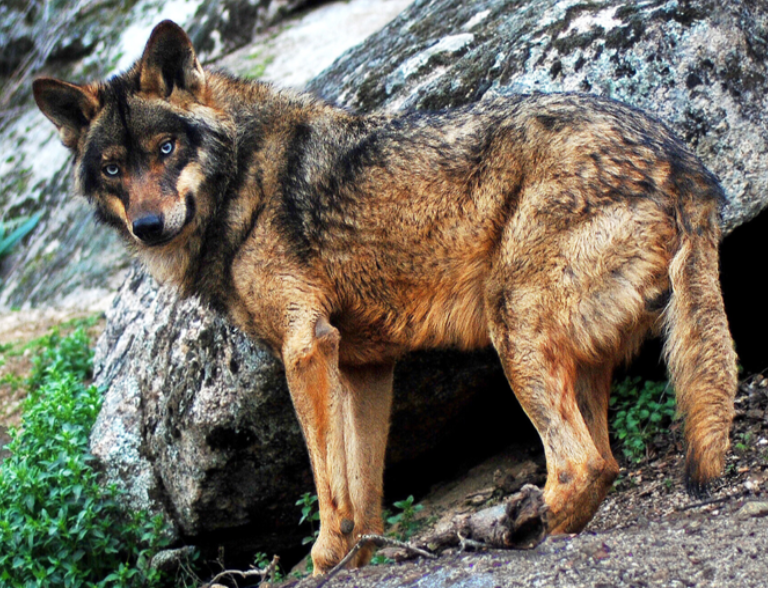
The Iberian wolf is not just a creature of ecological importance but also of cultural significance. It features prominently in Spanish folklore and mythology as a powerful and mystical being. Conservation efforts continue to be essential in preserving this iconic species, as they face threats from habitat loss, human-wildlife conflict, and illegal poaching. Educational programs and eco-tourism are critical tools in promoting the protection of the Iberian wolf, ensuring that it continues to be a symbol of the wild, untamed heritage of Spain.
The Iberian wolf's remarkable adaptation to its environment, complex social behavior, and mysterious allure make it an endlessly fascinating subject. As conservationists work to secure the future of these magnificent predators, our understanding and appreciation for the Iberian wolf continue to grow—deepening the connection between humans and the wild realms of Spain they call home. In the shadowed forests and the rugged peaks, the Iberian wolf's howl echoes, a reminder of the wilderness that still endures and the secrets it holds.
 1
Like
Published at 8:30 PM Comments (0)
1
Like
Published at 8:30 PM Comments (0)
Exploring the Vibrant Festivals of Spain in July and August 2024
Saturday, June 15, 2024
Spain, a country synonymous with vibrant festivals and cultural extravaganzas, offers an exciting lineup of events during the months of July and August. These summer months are a time when Spain bursts into a kaleidoscope of colour, music, and celebration, showcasing the rich traditions and modern vibrancy of its many regions. From the beats of flamenco to the rush of bull runs, the festivals during these months are a testament to Spain's enduring cultural heritage and its embrace of the joys of summer. Here, we delve into some of the most anticipated festivals set to take place in Spain during July and August 2024.
July Festivals in Spain
San Fermín (Pamplona)

When: July 6-14, 2024
The San Fermín festival, held in the historic city of Pamplona, is famously known for its encierro, or running of the bulls, an event that has captured the imagination of the world. It's a week of non-stop festivities that include traditional dances, parades, and bullfights. The San Fermín festival is a blend of courage, tradition, and endless fun, attracting thousands of visitors from across the globe. Donning the traditional white attire with red sashes and neckerchiefs, participants and spectators immerse themselves in what is undoubtedly one of Spain's most exhilarating festivals.
International Festival of Music and Dance (Granada)
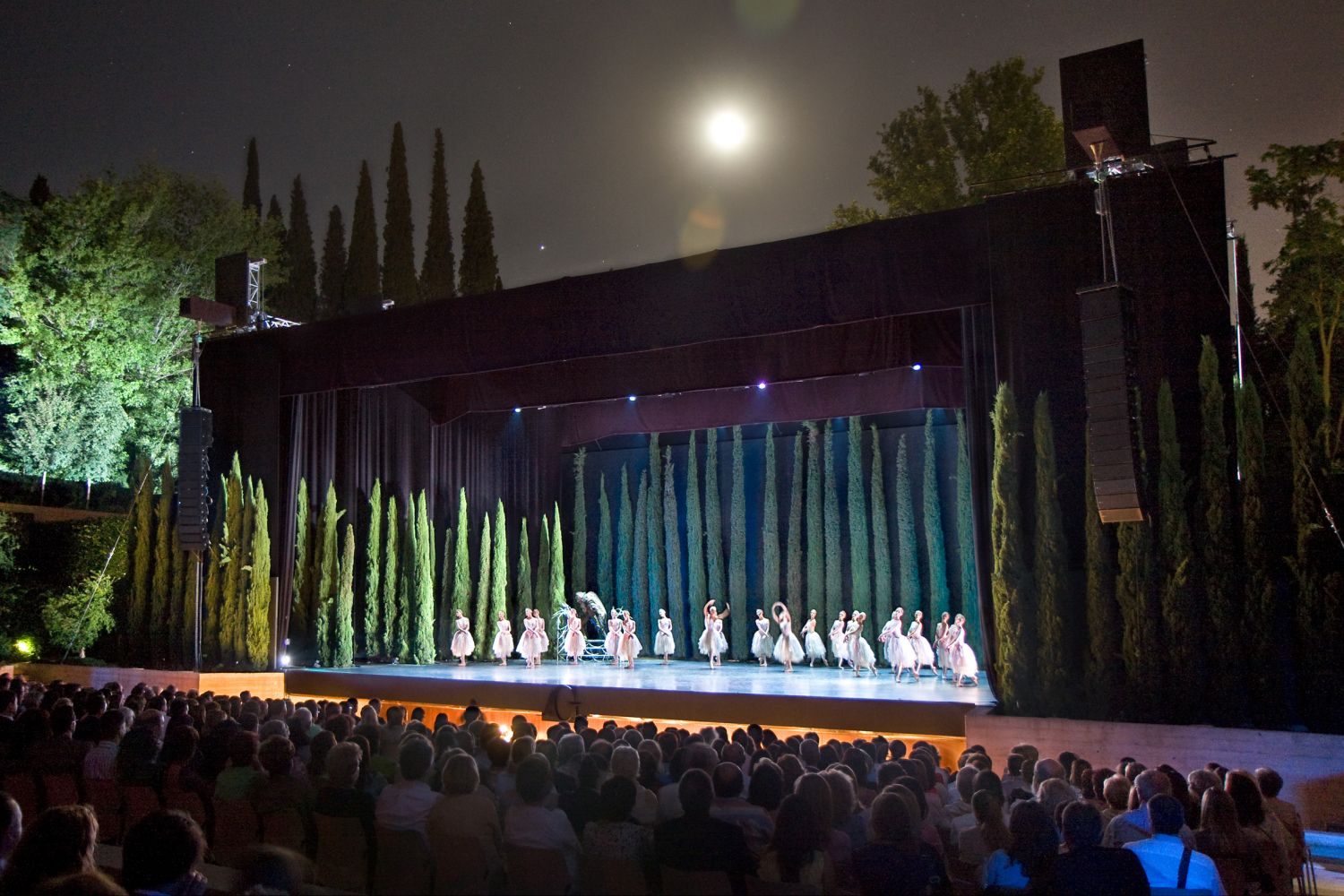
When: Late June to Mid-July 2024 (Exact dates TBD)
Drawing from Granada’s magical backdrop, the International Festival of Music and Dance is a celebration of the arts set within the iconic precincts of the Alhambra Palace, among other historical sites. Classical music, ballet, and flamenco performances by international and Spanish artists create an enchanting experience. It's a harmonious tribute to the cultural legacy of Granada, making it a must-visit for art lovers.
August Festivals in Spain
La Tomatina (Buñol)
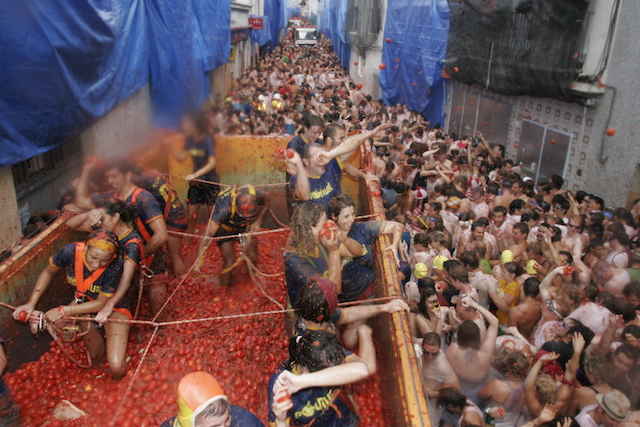
When: Last Wednesday of August 2024
La Tomatina is quite literally the messiest, yet one of the most fun-filled festivals in Spain, if not the world. Held in the small town of Buñol, participants from all over the globe gather for the world's biggest tomato fight. For several hours, the town transforms into a sea of red as thousands of people hurl tomatoes at each other. It's a unique spectacle that embodies the spirit of good-natured fun and camaraderie.
Festa Major de Gràcia (Barcelona)
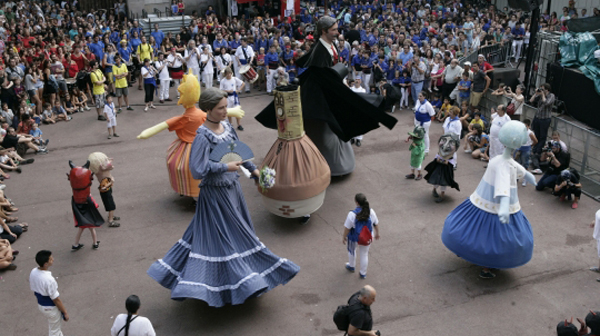
When: August 15-21, 2024
Barcelona's vibrant neighborhood of Gràcia hosts its Festa Major, a community-driven festival renowned for its elaborate street decorations created by the residents. Each street competes for the title of best-decorated street, turning the area into an open-air art gallery. Alongside the visual feast, there’s a plethora of concerts, workshops, and traditional Catalan activities, making it a quintessential celebration of community and creativity.
Semana Grande (Bilbao)
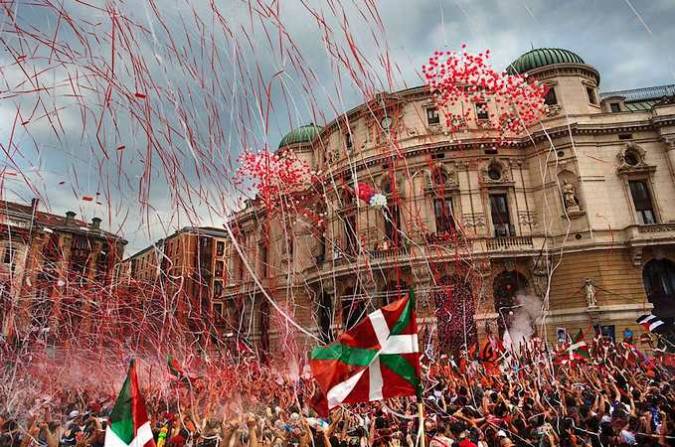
When: Sat, 17 Aug 2024 – Sun, 25 Aug 2024
Semana Grande, or Aste Nagusia, is Bilbao’s biggest festival, celebrating Basque culture with a week-long extravaganza of sports, concerts, street theatre, fireworks, and traditional Basque dance performances. The festival centres around the figure of Marijaia, the symbol of the festivities, who is ceremoniously burnt at the end, marking the conclusion of the celebrations. It’s a vibrant showcase of the Basque spirit, inviting everyone to partake in the festivities.
Spain in July and August 2024 promises a rich tapestry of experiences for any traveller. Each festival, with its unique charm and tradition, offers a window into the soul of Spain. Whether it's the adrenaline rush of San Fermín, the artistic elegance of the International Festival of Music and Dance in Granada, the sheer joy of La Tomatina, the community spirit of Festa Major de Gràcia, or the cultural pride of Semana Grande, Spain's summer festivals are a celebration of life itself. These events not only reflect the diversity and richness of Spanish culture but also offer an unforgettable experience to those lucky enough to partake. As the summer of 2024 beckons, Spain readies itself once again to showcase its heritage, its warmth, and its vibrancy through these spectacular festivals.
 0
Like
Published at 7:14 PM Comments (0)
0
Like
Published at 7:14 PM Comments (0)
Masterpieces of the Prado Museum: An Insight into the Most Valuable Pieces
Saturday, June 15, 2024
The Prado Museum in Madrid, Spain, is a treasure trove of fine art, housing one of the world's most impressive collections of European art. With its walls adorned by masterpieces from the 12th century to the early 19th century, the museum is a haven for art enthusiasts and historians alike. Its value lies not only in the sheer number of pieces it contains but in the remarkable quality and historical significance of its artworks. Here we will explore some of the most valuable and esteemed pieces of art on show in the Prado Museum.
"Las Meninas" by Diego Velázquez
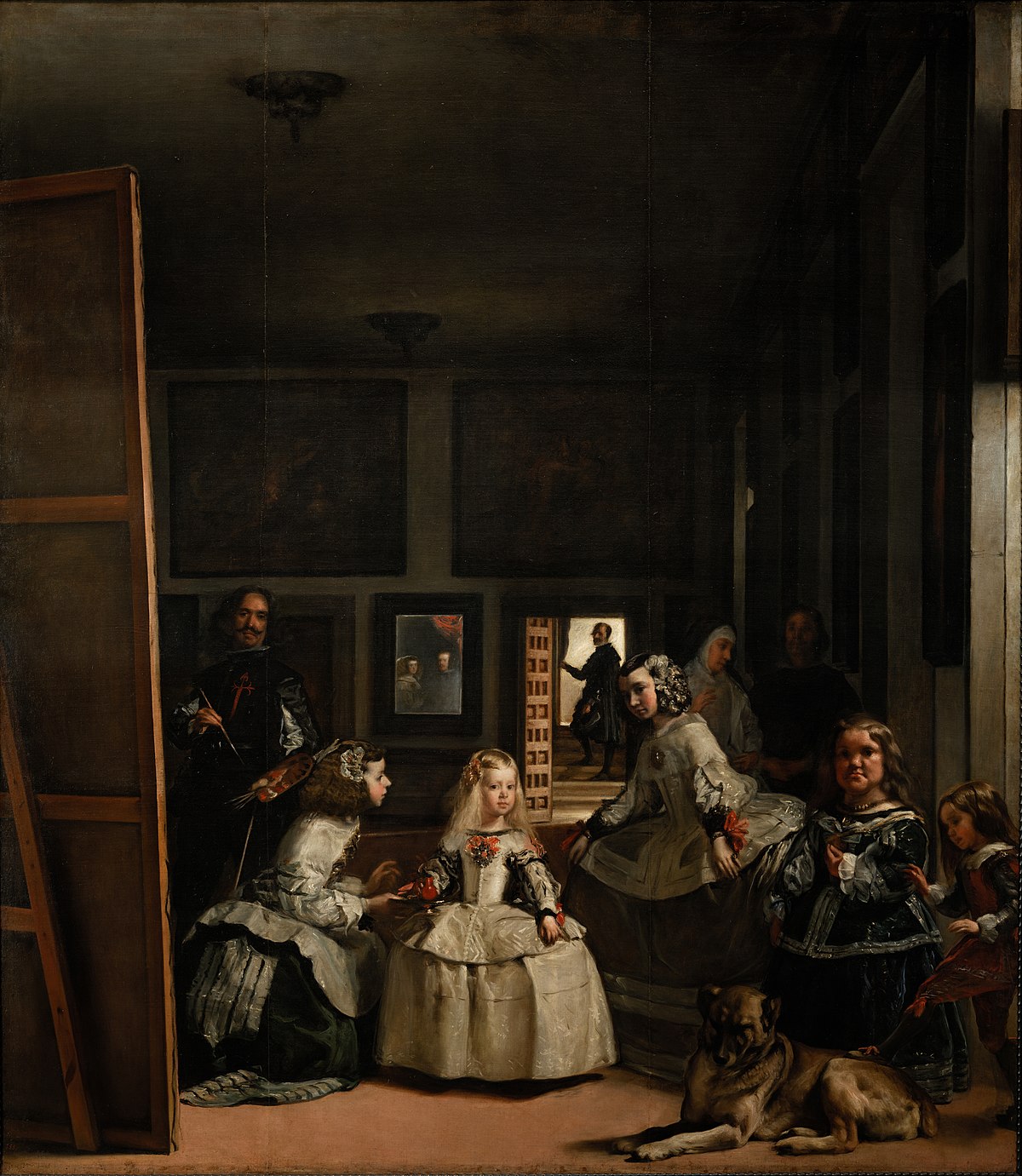
Diego Velázquez's "Las Meninas" is often heralded as the magnum opus of the Prado's collection and one of the most important paintings in Western art history. Painted in 1656, this masterpiece is a complex narrative of life in the court of King Philip IV of Spain. Velázquez, through his exceptional use of perspective and light, invites viewers to delve into the intricacies of the Spanish court, blending reality with illusion in a way that was revolutionary for its time. The painting's intricate composition and the enigmatic expressions of its figures continue to fascinate and puzzle art lovers and scholars.
"The Garden of Earthly Delights" by Hieronymus Bosch

Hieronymus Bosch's triptych, "The Garden of Earthly Delights," is another gem of the Prado. This late 15th or early 16th-century masterpiece is lauded for its intricate detailing and its vivid, sometimes surreal, portrayal of paradise and damnation. Bosch's imaginative depiction of Eden on the left panel; a central, earthly paradise filled with engaging, sometimes perplexing activities; and a hellish landscape on the right, make this work a compelling study of morality, sin, and redemption.
"The Annunciation" by Fra Angelico
.jpg)
"The Annunciation" by Fra Angelico, painted between 1425 and 1426, is one of the Renaissance's most sublime depictions of the Virgin Mary learning of her divine pregnancy. Fra Angelico's delicate handling of colour and light, as well as his attention to detail, imbues the scene with a serene, heavenly atmosphere. This work is celebrated for its spiritual depth and its quiet, yet profound, beauty. It is a testament to Fra Angelico's mastery and his ability to convey complex theological ideas through art.
"The Third of May 1808" by Francisco Goya

Francisco Goya's "The Third of May 1808" is a powerful and moving representation of the Spanish resistance during the Peninsular War. Painted in 1814, this work is groundbreaking for its emotive force and its stark depiction of the horrors of war. Goya's use of lighting to highlight the Spanish victims, contrasted with the faceless French firing squad, creates a poignant commentary on the tragedy of violence. This painting is not only a masterpiece of Spanish art but also a universal symbol of the struggle for freedom and justice.
"The Descent from the Cross" by Rogier van der Weyden

Rogier van der Weyden's "The Descent from the Cross," painted around 1435, is one of the Northern Renaissance's most celebrated masterpieces. Renowned for its emotional intensity and exquisite detail, the painting depicts Christ being lowered from the cross with a tenderness and compassion that is deeply moving. Van der Weyden's mastery of composition and his ability to convey human emotion make this work a cornerstone of early Netherlandish painting.
The Prado Museum is a veritable cornucopia of artistic treasures, and the works highlighted here represent just a fraction of its vast collection. Each piece, with its own unique story and historical context, contributes to the rich tapestry of European art history. Visitors to the Prado are afforded a rare opportunity to journey through centuries of artistic achievement, offering insights not only into the evolution of artistic styles and techniques but also into the very heart of human experience. Through its preservation of these timeless works, the Prado ensures that the beauty and genius of European art continue to inspire and enlighten future generations.
 0
Like
Published at 6:46 PM Comments (0)
0
Like
Published at 6:46 PM Comments (0)
Spam post or Abuse? Please let us know
|
|